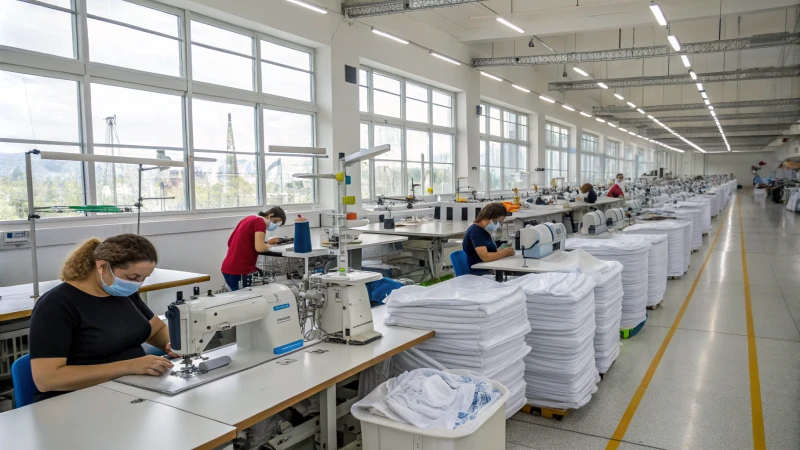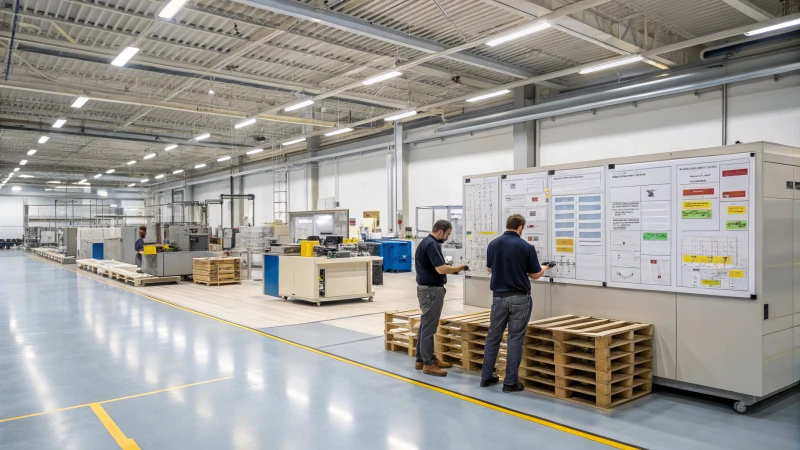
Ever felt the frustration of production delays wreaking havoc on your timelines and reputation?
To tackle production delays in underwear manufacturing, focus on strengthening your supply chain, adopting lean operations, leveraging technology for real-time insights, and fostering open communication with all stakeholders.
When I first faced significant production delays, I felt like I was caught in a whirlwind of chaos and uncertainty. It was then that I realized the value of diving deeper into each strategy. By tailoring these approaches to my specific manufacturing challenges, I found that efficiency improvements were not only possible but transformative. Let's explore how these methods can be customized to fit your unique context and drive meaningful change in your operations.
Lean practices reduce production delays in underwear manufacturing.True
Implementing lean practices streamlines operations, enhancing efficiency.
Ignoring supply chain issues doesn't affect production timelines.False
Supply chain issues can cause significant delays if not addressed.
How Can Lean Practices Improve Manufacturing Efficiency?
Ever wondered how lean practices could revolutionize your manufacturing process? Let me take you on a journey of discovery and efficiency.
Implementing lean practices can significantly boost manufacturing efficiency by streamlining operations, cutting down on waste, and fostering a culture of continuous improvement. By honing in on activities that add value, manufacturers can reduce costs and elevate productivity to new heights.

I remember the first time I dipped my toes into the world of lean manufacturing—it felt like unlocking a secret formula. It was during a particularly challenging project where we were constantly battling delays and inefficiencies. That's when I discovered the power of lean principles.
Understanding Lean Principles
Lean practices are all about creating more value with less work. It's like finding the magic spot where everything just clicks, and suddenly, your production line runs smoother than ever.
Key Techniques in Lean Manufacturing
5S Methodology
Imagine your workspace being as tidy as your kitchen counter after a thorough clean-up—everything in its place, ready for action. The 5S methodology (Sort, Set in order, Shine, Standardize, Sustain) achieves just that, ensuring no time is wasted hunting for tools or managing clutter.
Just-In-Time (JIT) Production
Picture this: producing exactly what you need right when you need it. That's the beauty of JIT production—slashing inventory costs and being nimble enough to adapt to the whims of demand. Dive deeper into Just-In-Time Production1.
Kaizen (Continuous Improvement)
Kaizen taught me that big changes often start small. By involving everyone and making incremental improvements, we cultivated an environment of constant innovation and teamwork.
| Technique | Benefit |
|---|---|
| 5S | Improves organization and reduces waste |
| JIT | Decreases inventory costs and increases responsiveness |
| Kaizen | Promotes continuous improvements and team collaboration |
Tools to Implement Lean Practices
- Value Stream Mapping (VSM): This visual tool was a revelation, offering a bird's-eye view of the production process that made spotting bottlenecks easier than ever.
- Kanban Systems: These systems became our silent overseers, making sure everything flowed seamlessly without overproduction hiccups. Explore more about Kanban Systems2.
Case Studies: Real-world Applications
Learning from others' experiences is invaluable. Real-world case studies in manufacturing industries3 showed me how lean practices reduced lead times and boosted productivity.
Incorporating lean practices like the 5S methodology, JIT production, and Kaizen transformed our operations. The secret? Continuous assessment and flexibility to stay competitive in this ever-changing market landscape. And trust me, when you see the results, it's like watching a well-oiled machine spring to life.
5S methodology reduces workplace clutter.True
5S organizes the workplace, minimizing time spent searching for tools.
Kaizen focuses on large, immediate changes.False
Kaizen emphasizes small, incremental improvements involving everyone.
How Does Technology Help in Reducing Production Delays?
Ever felt the sting of a production delay throwing a wrench into your manufacturing plans? I know I have. But thanks to technology, there are ways to dodge these disruptions and keep everything running smoothly. Curious how? Let’s dive in!
Technology reduces production delays by automating processes, boosting real-time communication, and optimizing supply chains. Tools like ERP systems and predictive analytics enhance efficiency and reduce downtime, ensuring seamless operations.

Automation: The Catalyst for Efficiency
I remember the first time I witnessed a robotic arm seamlessly taking over the assembly line tasks—it was like watching the future unfold before my eyes. Automation is transforming manufacturing by streamlining repetitive tasks, cutting down human errors, and upping the production speed. Technologies like robotic process automation (RPA) are game-changers here, especially in automating assembly lines. Then there are smart sensors that vigilantly monitor equipment in real-time, sending alerts for potential malfunctions before they cause any downtime4.
| Automation Technology | Benefits |
|---|---|
| RPA | Reduces manual errors, speeds up processes |
| Smart Sensors | Monitors equipment health, predicts failures |
Real-Time Communication Tools
I've learned the hard way how crucial communication is in preventing delays. Imagine coordinating a project only through sporadic emails—it's like playing a frustrating game of telephone! That's where integrated communication platforms come to the rescue. With cloud-based project management tools, teams can instantly update progress and make necessary adjustments, keeping bottlenecks at bay.
- Example: Picture a bustling manufacturing plant using Slack or Microsoft Teams to immediately address supply chain issues, saving the day from a looming delay.
Optimizing Supply Chains with ERP Systems
When I first explored Enterprise Resource Planning (ERP) systems, it was like discovering a superpower for managing supply chains efficiently. These systems consolidate data across departments, offering a unified view of the production process. It's like having a crystal ball for predicting demand accurately and managing inventory levels effectively, thus reducing production delays5.
Table: ERP System Benefits
Benefit Description Demand Forecasting Predicts future needs accurately Inventory Management Ensures optimal stock levels
Predictive Analytics: A Proactive Approach
It's almost magical how predictive analytics can transform heaps of historical data into insights that foresee potential disruptions. I've seen firsthand how this allows businesses to take proactive measures. By analyzing past data, manufacturers can predict when a machine might falter or when a supply shortage could occur.
- Example: Imagine a company planning maintenance schedules around predicted equipment failures6, effectively minimizing unexpected downtime.
Exploring these technologies reveals their collective power in minimizing production delays by enhancing operational efficiency and responsiveness. Integrating them into manufacturing processes not only reduces disruptions but also boosts overall productivity and competitiveness in the market.
RPA reduces manual errors in manufacturing.True
Robotic Process Automation (RPA) automates tasks, reducing human errors.
ERP systems do not aid in inventory management.False
ERP systems consolidate data for effective inventory management.
Why Is Supplier Relationship Management Crucial?
Ever wonder why some businesses seem to glide effortlessly through market changes while others stumble? The secret often lies in how they manage relationships with their suppliers.
Supplier Relationship Management (SRM) is vital for boosting efficiency, cutting costs, and sparking innovation. Focusing on SRM helps businesses trust suppliers, maintain quality, and build a robust supply chain ready to face market shifts.

Enhancing Efficiency Through SRM
I remember a time when a delay in supply almost brought our operations to a halt. It was a wake-up call about the importance of strong supplier relationships. Effective Supplier Relationship Management (SRM) means maintaining open lines of communication with suppliers, which significantly enhances operational efficiency. This approach ensures everyone is on the same page, reducing lead times and minimizing disruptions—like the ones I narrowly avoided.
Cost Savings and Financial Benefits
Think of SRM as an investment that pays off in more ways than one. By building long-term partnerships, I've been able to negotiate better prices and terms, which translates into significant cost savings. It's like having a trusted friend who always gives you the best deal. These partnerships can lead to better pricing strategies and volume discounts7, ultimately bolstering the bottom line.
| Benefit | Description |
|---|---|
| Cost Reduction | Negotiating better prices and terms with suppliers |
| Process Optimization | Streamlining operations to reduce waste |
Fostering Innovation and Collaboration
I’ve found that when you nurture relationships with suppliers, you're not just building a business connection; you're fostering an environment ripe for innovation. Suppliers are more inclined to share groundbreaking ideas and technologies with businesses they trust. This collaboration often leads to the development of innovative products8 that can set a company apart from its competitors.
Building Resilient Supply Chains
Remembering the chaos of market fluctuations makes me appreciate a resilient supply chain all the more. SRM is key to managing risks and ensuring a stable supply of materials. By having strong supplier relationships, I've been able to quickly adapt to market changes, thus minimizing supply chain disruptions9.
Trust and Quality Assurance
Trust is everything in business relationships. Investing in SRM has taught me that it's not just about transactions but about building genuine partnerships. This trust ensures consistent product quality because suppliers are more likely to prioritize clients who value their partnership. As a result, I enjoy enhanced quality control and reliable deliveries10.
SRM reduces lead times in supply chains.True
By fostering open communication, SRM enhances coordination, reducing lead times.
SRM increases operational costs significantly.False
SRM aims to lower costs through better terms and process optimization.
How can I communicate effectively with stakeholders during delays?
Have you ever felt the weight of silence when a project delay looms? Communicating effectively can turn potential chaos into collaboration.
To communicate effectively with stakeholders during delays, I focus on being transparent, timely, and empathetic. By clearly explaining the reasons for delays, outlining corrective actions, and keeping stakeholders regularly informed, I aim to maintain trust and collaboration.

The Importance of Transparency
I remember a project where we hit a snag because of a supply chain disruption11. It was like watching a well-rehearsed play suddenly go off-script. In those moments, I've learned that honesty is truly the best policy. I started by laying out the facts—what went wrong and why. Providing this context not only helps stakeholders understand the situation but also makes them feel included in the problem-solving process.
Timing Is Everything
I used to think it was better to wait until I had all the answers before saying anything. But then there was this one time when a last-minute update about a delay nearly derailed a client relationship. Now, I know that timing is crucial. It's about finding that sweet spot where you’re neither jumping the gun nor leaving things too late. Regular updates throughout the project keep everyone informed and show that you’re on top of things.
| Communication Timing | Suggested Actions |
|---|---|
| Initial Delay Notice | Explain causes, expected impact |
| Weekly Updates | Share progress, any changes |
| Post-Resolution | Summarize actions taken, outcomes |
Empathy in Communication
I once dealt with a particularly challenging delay where empathy became my best ally. Addressing concerns with understanding and offering reassurances reminded stakeholders that we were in this together. By genuinely acknowledging their frustrations, I was able to foster goodwill and strengthen our relationship despite the hiccups.
Utilize Technology for Updates
Incorporating tools like ERP systems12 has been a game-changer for me. These systems allow for real-time updates, meaning stakeholders can access information whenever they need it. This transparency reduces pressure on me as the project manager and ensures stakeholders always feel informed and valued.
Structured Feedback Mechanism
Opening up channels for feedback has often led to surprising insights. Whether through meetings or digital surveys, inviting stakeholders to voice their thoughts encourages collaboration. I’ve seen how this can lead to innovative solutions that might not have surfaced otherwise.
Embracing these strategies has transformed my approach to communicating during delays. It’s all about keeping the lines open, being honest, and showing a bit of empathy—because at the end of the day, we’re all working toward the same goal.
Transparency reduces stakeholder frustration during delays.True
Being transparent about delays helps stakeholders understand the situation, reducing frustration.
Delaying communication until resolution is best practice.False
Timely updates throughout the delay are crucial to prevent misunderstandings and maintain trust.
Conclusion
Effective strategies to mitigate production delays in underwear manufacturing include strengthening supply chains, adopting lean practices, leveraging technology, and fostering open communication with stakeholders.
Explore how Just-In-Time production minimizes waste and optimizes inventory management to meet demand efficiently. ↩
Discover how Kanban systems facilitate smooth workflow and prevent overproduction in manufacturing. ↩
Gain insights from real-world examples of successful lean practice implementations in manufacturing industries. ↩
Learn how smart sensors improve equipment efficiency by predicting maintenance needs, thus minimizing downtime. ↩
Discover how ERP systems streamline supply chain management by integrating various departmental data for better decision-making. ↩
Explore how predictive maintenance uses analytics to foresee equipment failures, reducing unexpected breakdowns. ↩
Volume discounts can significantly lower procurement costs, allowing businesses to invest savings elsewhere. ↩
Collaboration with suppliers fosters innovation by combining expertise to develop new products and technologies. ↩
Strong relationships ensure a reliable supply chain, helping businesses adapt quickly during disruptions. ↩
Trust leads to consistent quality and reliable deliveries, vital for maintaining business operations. ↩
Learn more about common causes of supply chain disruptions to better explain delay reasons to stakeholders. ↩
Discover how ERP systems enhance project management by providing real-time data for better decision-making. ↩






